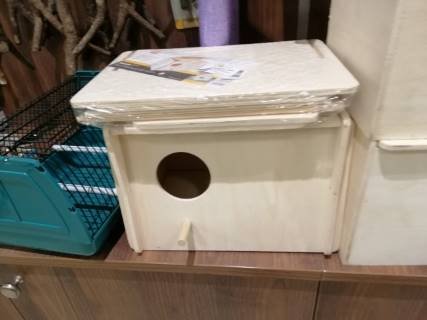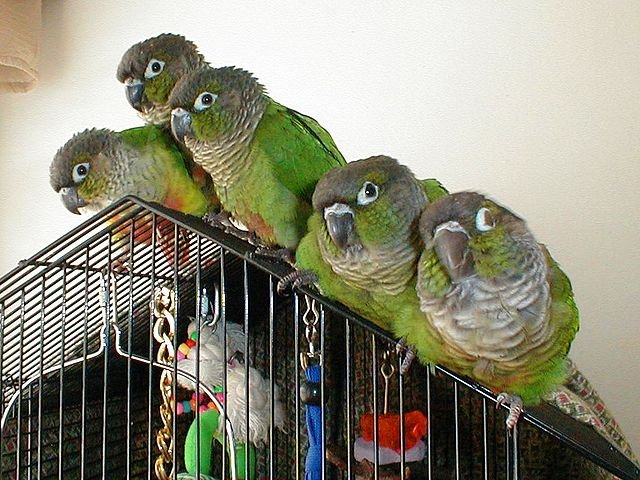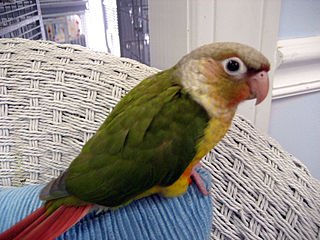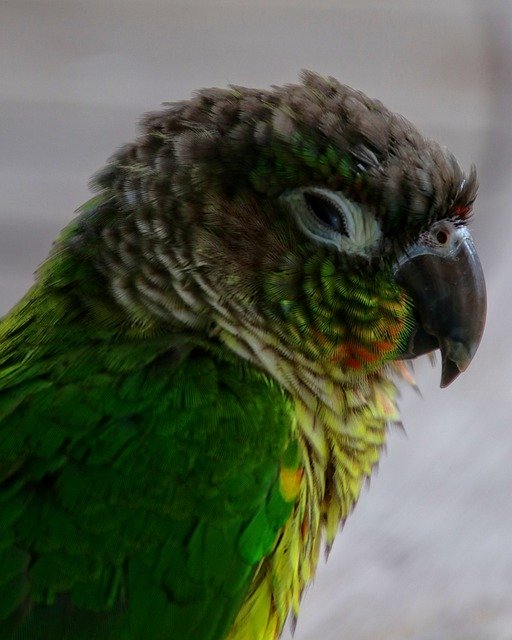Green cheek conures are found in flocks in varied regions of Brazil, Bolivia, Argentina, and Paraguay. They are one of the smallest members of the conure family. Extremely playful and social, green cheek conures are favored among parrot lovers due to their charming personality and vivid colors. An attractive cocktail of colors with an even more attractive persona, green cheek conures need more than just a few words to offer their true display of adorable-pet character.
Green-Cheeked Conure Names
Green cheek conures have a rich list of their other names. Green cheek conures are famous among Americans as green parakeets. Yet, they are called conures elsewhere. There are other names as well as various scientific names for the nominate green cheek conures and their subspecies.
Other names
- Green Cheek Parakeet
- Yellow-Sided Parrot
- Green Cheek Parrot
Scientific names
The scientific name for green cheek conure nominate species is Pyrrhura Molinae. They are further grouped into six subspecies. They are enlisted as follows:
- P. m. Molinae
- P. m. Restricta
- P. m. Phoenicura
- P. m. Australis
- P. m. Flavoptera
- P. m. Hypoxantha
More about Green Cheek Conure Mutations:
https://parrotquaker.com/green-cheek-conure-colors-and-mutations/
Green Cheek Conure Size & Weight
Green Cheek Conures are sized around 9 to 10 inches. They can weigh anywhere between 60 to 80 grams.
Green Cheek Conure Lifespan
The lifespan of a green cheek conure may vary with varying conditions. From the wilderness to captivity, from the healthy lifestyle to the neglected one, his longevity always depends on some defined values.
Green-cheek Conure Lifespan in the Wild
In the wild, green cheek conures can live anywhere between 10 to 15 years. They usually feed on South American fruits and vegetables. Though their diet is completely organic and fulfilling in the wild, there is nobody to ensure an apt balance of all the nutrients. This, at times, leads to health concerns which always goes unattended, thereby, impacting their longevity.
Loved for their playful nature, it sometimes ends up going against these fun-loving parakeets. Their love for playing and exploring often leads them to accidents which sometimes put them in life-threatening situations. Also, their fun banter easily attracts the attention of big predatory birds causing a threat to their life.
Green-cheeks are tree-top dwellers and it is not easy for any predator to attack them at such height. So, only two predators pose a threat. Their biggest predator is the Ornate Hawk-Eagle which can attack them easily at heights. The other is the False Vampire Bat which hunts them in the night.
Green-cheek Conure Lifespan in Captivity
In captivity, the average life expectancy of green parakeets increases surprisingly. And for the upper range, green cheek conures can live up to 35 years in captivity. Green-cheeks are very popular as pets as they can provide a loyal commitment for years. But this mean feat is achieved only with proper care and a balanced nutritious diet.
The average lifespan of green cheek conures in captivity is 25 years. Normally, they tend to live for around 25 years when taken care of with general instructions.
However, if the owner neglects these affectionate parrots, their lifespan decreases and might even equal to the one in the wild. Green cheek conures are attention seekers. If the owner continuously fails to spend time with him/her, they are more likely to get stressed and depressed. The lifespan of such green cheek conures lies between 10 to 15 years. They don’t have anyone to take care of them in the wild, and here in captivity, they still feel the same then.
Another factor that affects green cheek conures’ lifespan is their health conditions. Green cheek conures have bleeding syndromes. It leads to a lack of Vitamin K and indicates Pacheco’s disease. Though their other conures like Nanday or Patagonian Conures are resistant to this disease, it may reduce the green cheek’s life expectancy, if not addressed timely.
Green Cheek Conure Colors
Though green cheek conures aren’t as colorful as other conures, they’re still a sight to behold. They are typically bright green. The crown of green cheek conures is black. He has white eye-rings, grayish ears, and of course, the customary green cheeks. The nails and beak are black. The feet of green cheek conures are pinkish. The pointed tail of a green cheek is dark-maroon and they have cobalt-blue flight feathers. Both male and female green-cheeks are visually identical and difficult to tell apart.
Maroon-bellied vs Green-Cheek Conure
A distinct color marking is the gray scallops that fade away into the slightly maroon belly. This interesting marking makes many confuse green-cheeks with maroon-bellied conures. But all that is needed is a careful look at maroon-bellied scallops being distinctively golden than gray as in green-cheeks. Also, the maroon belly of maroon-bellied conures is marked heart-shaped, which is not the case in green-cheeks. For best maroon-bellied vs green-cheek conures answer, compare the color of their plumage; the latter has it brighter.
Blaze-winged vs Green-Cheek Conure
Almost identical in appearance, the Blaze-winged Conures can be distinguished from Green-cheeks with a keen eye. The crown area happens to be just dusky, unlike the green-cheek that has a prominent gray/black tone. And the other notable distinction that never fails is the red shoulder region along with red underwing coverts. The green-cheeks lack such blaze coloring on their shoulders and underwings.
Black-Capped vs Green-Cheek Conure
Confusion between a black-capped conure and a green-cheek is not uncommon. But when compared to green-cheeks mix-up with a blaze-winged conure, this seems rather easy for a few apparent differences. A darker green plumage, contrary to the green cheek’s brighter one; a rather prominent white scallops on the upper breast; and an overall green tail with a shade of black at the lower end. All these differences are big enough to tell both the conure species apart easily.
How to breed Green Cheek Conure
Green cheek conures are one of the easiest to breed. They get sexual maturity between the age of one to three years. Many of them can be mature before this age, but it’s not advisable to breed them younger.
If provided with a proper environment, green cheek conures can perform satisfying breeding. A sweet and gentle temperament in the environment makes a huge difference. A happy green-cheek focuses only on his mate, making the breeding process a success.
The average clutch of green cheek conures is 5-6 eggs. The incubation is expected in around 24 days. However, it may vary from 22 to 26 days.
Breeding Environment
Like all other living beings, green-cheeks also love to have their place they can call home. A home-like cozy place not only lends them a much-needed comfort but also a sense of privacy. Setting up a nesting box near the top of the darkest corner of their cage offers these birds ample privacy for breeding. The dimension of a nesting box must measure at least 12″×12″×18″. Satisfying breeding requires a larger nesting. 16 inches by 24 inches nest box is preferred for green cheek conures. But it must not be as large as a cage as the pair might abandon it for lack of the snug fit.

Shield the box from too much heat or light in warmer months. Otherwise, they may overheat. The internal dimension of the nesting box must be 6 to 8 inches and the entrance hole must be of 3 inches in diameter. The lid should always be removable so that inspection and cleaning can be done.
Keep the layer at the bottom of the nesting box at around 2 inches. Choosing the material carefully will play a vital role, as the purpose is two-fold. The preferred material is nontoxic sawdust, shredded newspaper, clean straw, or corn cobs. Wood shavings can also be used, but one must make sure to select larger chips. Otherwise, the chick may eat it.
Providing a playing opportunity encourages the mating of green cheek conures. Being a social and playful bird, physical activity helps keep a green-cheek happy and full of vigor. Maintaining a proper diet and daily bathing at the time of breeding is also very important. The diet must contain healthy fruits, vegetables, seeds, and prepared pelleted food. Minimizing table scraps to avoid extra weight is another important factor to consider. This would help in preventing the pair from getting obese. Additionally, a calcium supplement should be added to the female green cheek conures’ diet. It would prevent fatal egg binding in them.
Green Cheek Conure Talking Ability
Green cheek conures aren’t the best talkers of the conure family. Neither are they the frequent talkers. They develop their talking abilities at the age of around 2-3 months. Green cheek conures can be taught a couple of vocabulary. Yet, they have a limited vocabulary only. Generally, they start with speaking words like “up up”. They like to have human interactions and even try to mimic human voices. However, with some effort and patience, green cheeks can also be good talkers.
Are Green Cheek Conure loud?
Owing to their limited speech learning skills, green-cheeks don’t talk too much. They are one of the quietest conures. Neither are they loud when they talk. Green-cheeks are an ideal pet for the people who don’t want their bird to make a lot of noise. They make deep and low noises. So even when they talk, they hardly say something that can be perceived as loud in comparison to other loud conure species.
Green Cheek Conure Cage
To keep a green cheek conure happy and healthy, it is vital to get them an ideal cage. The minimum size of the cage of a green cheek conure must be 18 inches in length and breadth, and 24 inches in height with a metal mesh with half an inch of bar spacing. A larger cage is usually better as it gives ample space to these playful birds to take short flights and hop around comfortably.
Just like the cage size, it is imperative to maintain optimum cage conditions. Green cheeks do well in the temperature that lies between 65 to 80 degrees Fahrenheit. Also, cleaning the cage with a wet wipe weekly or fortnightly would ensure the best hygiene.

Along with this, multiple perches and food cups must be offered in their cage.
A metal grate must always be placed over the droppings tray. It would prevent contamination until the next cleaning sessions.
If there are varied parrot species, it is wise not to house them together in the same cage, especially with a breeding pair.
Green Cheek Conure Food
The best diet for the green-cheek conures must be filled with calcium, minerals, and nutrients. The nutrition they require in their diet are vitamins, calcium, amino acids, essential oils, and other vital minerals. To fulfill all these requirements, they must be served with a variety of fresh fruits and vegetables, healthy nuts and seeds, and healthy table foods.
As green cheeks are native to South America, they are naturally inclined towards South American foods. In the wild, green cheek conures feed on vegetables, fruits, and seeds. Also, they love eating insects occasionally.
The diet of green cheeks as pets must be similar to what they eat in the wild. One can offer several foods to these birds. Offer them a balanced mix of carbohydrates, vitamins, proteins, and other sources of minerals.
The first thing that must be served to them daily is fresh fruits and vegetables. The various fruits that can be offered to green cheeks are fresh Washington apples, bananas, mangoes, papayas, kiwis, peaches, figs, and passionfruit.
The next on the list is a fair dose of seasonal vegetables. These make the bird’s feed wholesome along with adding a wide range of vitamins, and minerals. Green cheeks can be offered leafy greens such as basil, turnip greens, broccoli, spinach, kale, chard, celery. Apart from leafy greens, peas, carrots, pumpkin, winter squash, and red chilies are also good for them.
A healthy diet for green cheek conures features a variety of grains, beans, and legumes. They can be fed such foods in the morning as the first meal. Grains and beans are high in fiber. Serve them oats, quinoa, brown rice, or wheat toast to give them their energy shots.
Nuts are a source of healthy and natural fats. They are essential for a green cheek’s optimal health. These birds can be fed almonds, walnuts, pumpkin seeds, peanuts, sunflower seeds, and pecans. However, such foods are fatty and hence must be offered sparingly.
Green cheek conures occasionally eat insects in the wild. Therefore, to keep their protein pangs satisfied, meats and dairy products can also be offered to them.
When talking about the best food, one must also know what food is not good for a pet bird. In the case of green cheek conure, the avoidable foods have a huge impact on their health. Serving such foods can even be fatal to them. So, one should never offer green cheeks foods like avocado, chocolate, alcohol, caffeine, lettuce, apple seeds. Additionally, garlic, onion, chips, fast food, and processed foods must also be avoided.
Green Cheek Conure Health
Green cheek conures often deal with damaged feathers during autumn. Therefore, proper care for them is vital. Their diet must be supplemented with pellets. They require enough vitamins and minerals.
The possible health concerns for green cheek conures are:
- Bleeding
- Coughing
- Sitting on the cage floor
- Fluffed up or messy feathers
- Favoring one foot when not sleeping
- Beak swelling or accumulation
- Eye discharge, eye redness, inflammation, or other eye issues
- Appetite loss
- Nasal discharge
For the best mental care, green cheek conures should not be kept alone. This saves these birds from falling into depression because of loneliness.
How to Care for a Greek-Cheek Conure?
Green cheek conures are attention seekers. The owner must spend at least 3-4 hours with them. To keep these birds healthy and happy, they should be provided with plenty of toys. Toys ensure not only their mental but physical health too.
Green cheek conures love to bath. They must be bathed daily to keep dirt and germs away. Often, green-cheeks might catch father-related diseases for lack of hygiene. To lure the bird into the water quickly, one can offer a low, glass pie pan to make a great bathtub. Get their beak and nails trimmed regularly and clip their flight feathers, if necessary
Green Cheek Conure Intelligence
Green cheek conures are undoubtedly an intelligent species. They are capable of learning new things, tasks, and vocabulary. They always seem curious about their training. Their playful and social nature makes them want to learn new tricks and techniques.
Conclusion
Green cheek conures are loved among parrot lovers. They can be the very first choice for a beginner pet owner. That said, seasoned parrot lovers also often love having them as their companions. The reason being the playful and intelligent nature of green cheek conures makes them stand out from the conure family. All they need is a healthy diet and a gentle environment to have a comfortable stay. With proper attention and affection, they have been a proven loyal companion for up to 35 years.
Featured Photo Credit : Tiermensch at English Wikipedia / Public domain




